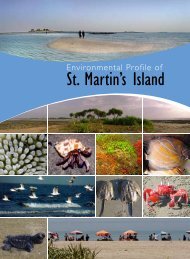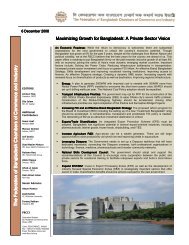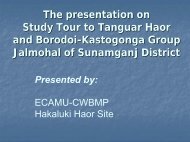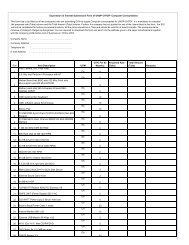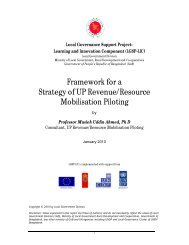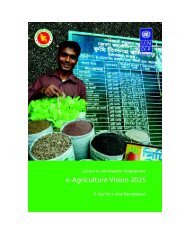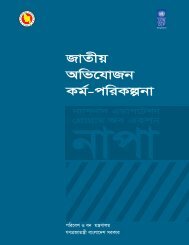The probable impacts of climate change on poverty - UNDP
The probable impacts of climate change on poverty - UNDP
The probable impacts of climate change on poverty - UNDP
You also want an ePaper? Increase the reach of your titles
YUMPU automatically turns print PDFs into web optimized ePapers that Google loves.
Flood, drought, cycl<strong>on</strong>e, sea level rise etc. are the major <str<strong>on</strong>g>climate</str<strong>on</strong>g> induced natural disasters which cause loss <str<strong>on</strong>g>of</str<strong>on</strong>g><br />
livestock, damage pasturelands, increase fodder scarcity, destroy shelters, decrease producti<strong>on</strong>, increase<br />
management cost through incidence <str<strong>on</strong>g>of</str<strong>on</strong>g> diseases etc. It is also perceive that severe <str<strong>on</strong>g>impacts</str<strong>on</strong>g> <str<strong>on</strong>g>of</str<strong>on</strong>g> <str<strong>on</strong>g>climate</str<strong>on</strong>g> <str<strong>on</strong>g>change</str<strong>on</strong>g><br />
and extremes <strong>on</strong> livestock affect <strong>poverty</strong> moderately. But the <str<strong>on</strong>g>impacts</str<strong>on</strong>g> <str<strong>on</strong>g>of</str<strong>on</strong>g> sea level rise affects <strong>poverty</strong> and<br />
ec<strong>on</strong>omic growth <str<strong>on</strong>g>of</str<strong>on</strong>g> this particular sector severely as stated by the key experts. Drought, salinity intrusi<strong>on</strong> and heat<br />
wave affect the sector moderately and c<strong>on</strong>sequently, both <strong>poverty</strong> and ec<strong>on</strong>omic growth are moderately affected.<br />
Thus, the <str<strong>on</strong>g>impacts</str<strong>on</strong>g> <str<strong>on</strong>g>of</str<strong>on</strong>g> <str<strong>on</strong>g>climate</str<strong>on</strong>g> <str<strong>on</strong>g>change</str<strong>on</strong>g> <strong>on</strong> livestock affect <strong>poverty</strong> reducti<strong>on</strong> activities and in attaining the MDGs.<br />
<str<strong>on</strong>g>The</str<strong>on</strong>g> <str<strong>on</strong>g>impacts</str<strong>on</strong>g> <str<strong>on</strong>g>of</str<strong>on</strong>g> extreme weather events especially, cycl<strong>on</strong>e and storm surge <strong>on</strong> forestry affect <strong>poverty</strong> and<br />
ec<strong>on</strong>omic growth in different ways. <str<strong>on</strong>g>The</str<strong>on</strong>g> supper cycl<strong>on</strong>e Sidr destructed <strong>on</strong>e-quarter <str<strong>on</strong>g>of</str<strong>on</strong>g> the Sundarbans and<br />
almost 100% afforested trees al<strong>on</strong>g its path. Poverty is severely affected by cycl<strong>on</strong>e in the c<strong>on</strong>text <str<strong>on</strong>g>of</str<strong>on</strong>g> severity <str<strong>on</strong>g>of</str<strong>on</strong>g><br />
impact <strong>on</strong> forestry. Livelihoods <str<strong>on</strong>g>of</str<strong>on</strong>g> the poor and marginal communities in the forest areas, especially in the<br />
Sundarbans area mostly depend <strong>on</strong> forest resources. Very pertinently, <str<strong>on</strong>g>impacts</str<strong>on</strong>g> <str<strong>on</strong>g>of</str<strong>on</strong>g> shocks <strong>on</strong> forestry affect the<br />
poor <str<strong>on</strong>g>of</str<strong>on</strong>g> that particular livelihood group. It is perceived that salinity intrusi<strong>on</strong> severely affect forest trees and<br />
resources especially in the coastal regi<strong>on</strong>. This has moderate <str<strong>on</strong>g>impacts</str<strong>on</strong>g> <strong>on</strong> <strong>poverty</strong> and ec<strong>on</strong>omic growth. <str<strong>on</strong>g>The</str<strong>on</strong>g><br />
other shocks like flood and drought have moderate <str<strong>on</strong>g>impacts</str<strong>on</strong>g> <strong>on</strong> forestry which has low <str<strong>on</strong>g>impacts</str<strong>on</strong>g> <strong>on</strong> <strong>poverty</strong> and<br />
ec<strong>on</strong>omic growth. Besides this, erratic rainfall and temperature variati<strong>on</strong> have low <str<strong>on</strong>g>impacts</str<strong>on</strong>g> <strong>on</strong> forestry and lower<br />
<str<strong>on</strong>g>impacts</str<strong>on</strong>g> <strong>on</strong> <strong>poverty</strong>.<br />
It is likely that the gradual <str<strong>on</strong>g>change</str<strong>on</strong>g> phenomena such as temperature rise and erratic behaviour <str<strong>on</strong>g>of</str<strong>on</strong>g> rainfall will lead<br />
to increased water demand and drought while sea level rise and salinity intrusi<strong>on</strong> will deteriorate water quality in<br />
the coastal regi<strong>on</strong>. Climate <str<strong>on</strong>g>change</str<strong>on</strong>g> related extreme events particularly cycl<strong>on</strong>e and storm surge will damage<br />
water supply and sanitati<strong>on</strong> infrastructure particularly in the coastal regi<strong>on</strong>.<br />
Flood and cycl<strong>on</strong>e are the two major climatic events which affect industry sector severely. <str<strong>on</strong>g>The</str<strong>on</strong>g> women workers<br />
involved in handloom become fully unemployed during flood. In the coastal area, industry and infrastructure are<br />
mainly affected by cycl<strong>on</strong>e and storm surge. It destroys buildings <str<strong>on</strong>g>of</str<strong>on</strong>g> industries and machineries in <strong>on</strong>e hand; <strong>on</strong><br />
the other hand, it destroys roads and other communicati<strong>on</strong> networks, power supply networks, water supply<br />
networks, and causes health degradati<strong>on</strong> and death <str<strong>on</strong>g>of</str<strong>on</strong>g> workers. Moreover, salinity has large scale <str<strong>on</strong>g>impacts</str<strong>on</strong>g> <strong>on</strong><br />
industry.<br />
Human health suffers from different climatic variability and shocks in different ways. It is revealed from the<br />
analysis that health is affected, especially during and after shocks like flood and cycl<strong>on</strong>e. Flood affects sources <str<strong>on</strong>g>of</str<strong>on</strong>g><br />
drinking water and sanitati<strong>on</strong> system through c<strong>on</strong>taminati<strong>on</strong> which lead to out break <str<strong>on</strong>g>of</str<strong>on</strong>g> diarrhoea, cholera, skin<br />
diseases including scabies, drowning, snake bite and even death. Cycl<strong>on</strong>e, sea level rise and salinity intrusi<strong>on</strong><br />
cause outbreaks <str<strong>on</strong>g>of</str<strong>on</strong>g> diarrhoea, cholera and other water borne diseases, use <str<strong>on</strong>g>of</str<strong>on</strong>g> saline water causes hypertensi<strong>on</strong>,<br />
increase blood pressure, corrosive effects due to salt in air, scabies and other skin diseases. Besides that, drought,<br />
erratic rainfall and temperature variati<strong>on</strong> increase vector borne diseases, heat stroke, malnutriti<strong>on</strong>, fever etc. Cold<br />
wave creates respiratory problem, especially that <str<strong>on</strong>g>of</str<strong>on</strong>g> children and the old.<br />
Strategies and acti<strong>on</strong>s suggested in the report to deal with adverse <str<strong>on</strong>g>impacts</str<strong>on</strong>g> <str<strong>on</strong>g>of</str<strong>on</strong>g> present and future <str<strong>on</strong>g>climate</str<strong>on</strong>g><br />
<str<strong>on</strong>g>change</str<strong>on</strong>g> and related disasters are based <strong>on</strong> suggesti<strong>on</strong>s derived from different c<strong>on</strong>sultati<strong>on</strong> workshops and key<br />
experts’ interviews. Key principles c<strong>on</strong>sidered in formulating strategies and acti<strong>on</strong>s were a) reducti<strong>on</strong> <str<strong>on</strong>g>of</str<strong>on</strong>g> exposure<br />
<str<strong>on</strong>g>of</str<strong>on</strong>g> income stream and producti<strong>on</strong> systems, b) reducti<strong>on</strong> <str<strong>on</strong>g>of</str<strong>on</strong>g> sensitivity <str<strong>on</strong>g>of</str<strong>on</strong>g> the exposed systems, and c) increase<br />
adaptive capacity <str<strong>on</strong>g>of</str<strong>on</strong>g> vulnerable communities. Instituti<strong>on</strong>al and capacity building aspects to support<br />
implementati<strong>on</strong> <str<strong>on</strong>g>of</str<strong>on</strong>g> acti<strong>on</strong>s have also been c<strong>on</strong>sidered. It was found that there is similarity <str<strong>on</strong>g>of</str<strong>on</strong>g> suggesti<strong>on</strong>s<br />
menti<strong>on</strong>ed here and in the nati<strong>on</strong>al <str<strong>on</strong>g>climate</str<strong>on</strong>g> <str<strong>on</strong>g>change</str<strong>on</strong>g> strategy and acti<strong>on</strong> plan.<br />
In order to address adverse <str<strong>on</strong>g>impacts</str<strong>on</strong>g> <str<strong>on</strong>g>of</str<strong>on</strong>g> <str<strong>on</strong>g>climate</str<strong>on</strong>g> <str<strong>on</strong>g>change</str<strong>on</strong>g> and reducti<strong>on</strong> <str<strong>on</strong>g>of</str<strong>on</strong>g> greenhouse gas emissi<strong>on</strong> in the c<strong>on</strong>text<br />
<str<strong>on</strong>g>of</str<strong>on</strong>g> <strong>poverty</strong> and nati<strong>on</strong>al ec<strong>on</strong>omic growth, a number <str<strong>on</strong>g>of</str<strong>on</strong>g> <str<strong>on</strong>g>change</str<strong>on</strong>g>s have been suggested by different stakeholders<br />
including <str<strong>on</strong>g>change</str<strong>on</strong>g>s in planning process while designing programs and projects by different ministries and<br />
departments in the <str<strong>on</strong>g>climate</str<strong>on</strong>g> sensitive geographical regi<strong>on</strong>. <str<strong>on</strong>g>The</str<strong>on</strong>g>se include short, medium and l<strong>on</strong>g term<br />
perspective <str<strong>on</strong>g>of</str<strong>on</strong>g> <str<strong>on</strong>g>climate</str<strong>on</strong>g> <str<strong>on</strong>g>change</str<strong>on</strong>g>, create enabling c<strong>on</strong>diti<strong>on</strong>s to incorporate <str<strong>on</strong>g>climate</str<strong>on</strong>g> <str<strong>on</strong>g>change</str<strong>on</strong>g> perspectives, ensure<br />
participati<strong>on</strong> <str<strong>on</strong>g>of</str<strong>on</strong>g> all relevant stakeholders particularly potential vulnerable communities to <str<strong>on</strong>g>climate</str<strong>on</strong>g> <str<strong>on</strong>g>change</str<strong>on</strong>g>.<br />
<str<strong>on</strong>g>The</str<strong>on</strong>g> Probable Impacts <str<strong>on</strong>g>of</str<strong>on</strong>g> Climate Change <strong>on</strong> Poverty and Ec<strong>on</strong>omic Growth and<br />
the Opti<strong>on</strong>s <str<strong>on</strong>g>of</str<strong>on</strong>g> Coping with adverse Effect <str<strong>on</strong>g>of</str<strong>on</strong>g> Climate Change in Bangladesh<br />
xv



